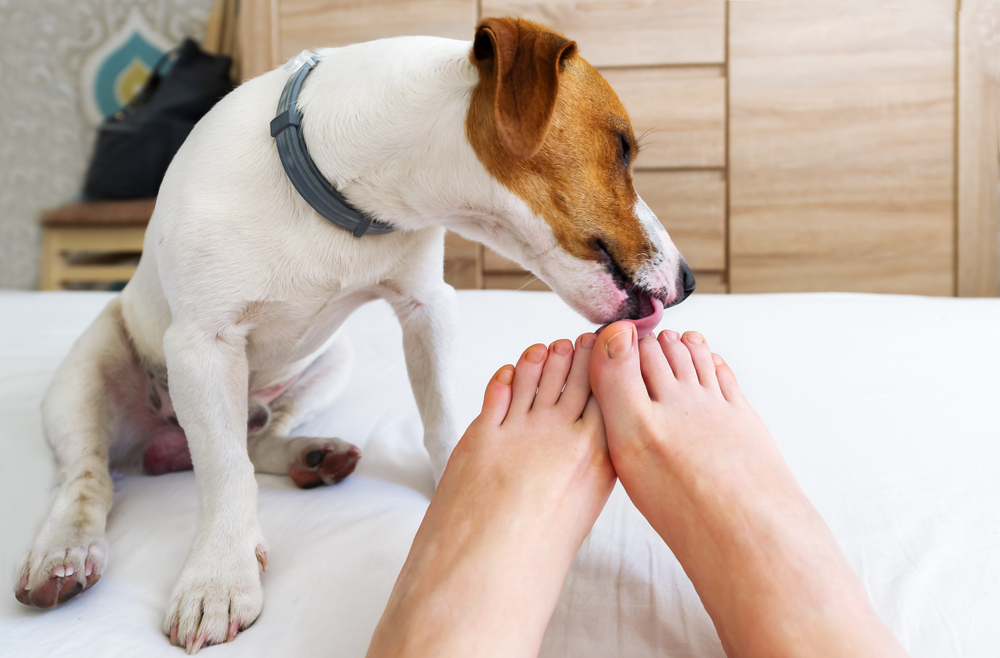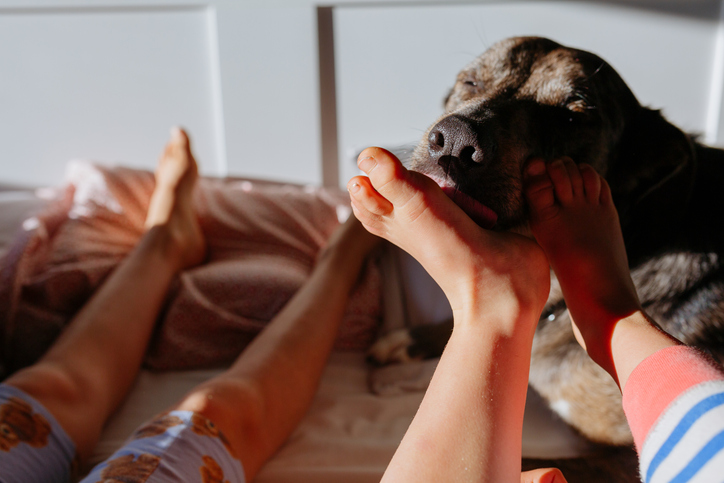Dogs are known for their peculiar behaviors, and one common behavior that leaves many pet owners scratching their heads is the act of licking their feet. Why do our canine companions seem so interested in our feet? Is it a sign of affection, curiosity, or something else entirely? In this comprehensive guide, we’ll explore the various reasons behind why dogs lick feet, debunk myths, and offer tips on how to manage or redirect this behavior.
Before delving into the specifics of why dogs lick feet, it’s essential to understand that canine behavior is complex and multifaceted. Dogs communicate and interact with their environment and humans through a combination of body language, vocalizations, and actions. Licking is just one of many ways dogs express themselves and navigate their world.
Reasons Why Dogs Lick Feet

1. Communication and Exploration
Licking as a Communication Tool:
Dogs rely heavily on their sense of smell to gather information about their surroundings and the people they encounter. When a dog licks your feet, they are utilizing their powerful olfactory senses to gather information about you. Your feet carry unique scents that can tell your dog where you’ve been, what you’ve been doing, and even how you’re feeling. In the canine world, scent plays a crucial role in communication, allowing dogs to exchange information about their environment, other animals, and their human companions. By licking your feet, your dog is engaging in a form of communication, albeit non-verbal, to learn more about you and your activities.
Exploration of the Environment:
Dogs are naturally curious creatures, and licking is one way they explore and interact with their environment. Your feet may present an intriguing sensory experience for your dog, prompting them to investigate further through licking. Dogs use their mouths as a primary means of exploring objects and surfaces, relying on taste and texture to understand their surroundings. By licking your feet, your dog may be satisfying their innate curiosity and gaining a better understanding of the world around them. This behavior is particularly common in puppies, who are still learning about their environment and may use licking as a means of discovery.
2. Affection and Bonding
Displaying Affection:
Licking is often considered a sign of affection and bonding in dogs. When your dog licks your feet, they may be expressing their love and devotion to you. In the canine world, licking is a common behavior seen between family members and pack mates as a way to strengthen social bonds. Dogs form strong emotional attachments to their human companions, and licking serves as a form of communication to convey feelings of affection and closeness. Your dog may lick your feet as a way to express their love and reinforce the bond between you.
Seeking Comfort and Reassurance:
Dogs may also lick their owner’s feet as a way to seek comfort and reassurance. Your dog may find solace in the familiar scent and taste of your feet, especially during times of stress or anxiety. Licking can be a soothing behavior for dogs, providing them with a sense of security and comfort in the presence of their trusted human companion. By licking your feet, your dog may be seeking reassurance and emotional support, finding comfort in the physical connection with you. This behavior is especially common in dogs that have formed strong attachments to their owners and rely on them for emotional support and comfort.
3. Greeting and Attention-Seeking
Greeting Rituals:
Dogs have various ways of greeting their owners, and licking is often included in their repertoire. When you come home after being away, your dog may greet you by licking your feet as a way of saying hello and showing excitement. In the wild, wolves and other canines greet each other by licking one another’s faces and bodies as a sign of social bonding and acknowledgment. Similarly, domestic dogs may lick their owner’s feet as a form of greeting and acknowledgment, signaling their excitement and happiness at seeing you again. This behavior is an expression of your dog’s joy and eagerness to interact with you after a period of separation.
Attention-Seeking Behavior:
Dogs are social animals that crave attention and interaction with their human companions. Licking your feet may be your dog’s way of seeking attention from you. They may have learned that licking elicits a response from you, whether it’s laughter, petting, or verbal acknowledgment. Dogs are highly attuned to human behavior and may engage in licking as a way to initiate interaction and engagement with you. By licking your feet, your dog is signaling their desire for attention and seeking to engage with you in a positive and interactive manner. This behavior is common in dogs that enjoy close physical contact with their owners and seek out opportunities for social interaction and bonding.
4. Sensory Stimulation
Taste and Scent:
Our feet emit various scents and flavors that can be appealing to dogs. Sweat, in particular, contains salt and other compounds that may attract dogs to lick our feet. Additionally, dogs have a keen sense of smell that allows them to detect subtle odors, including pheromones and chemical signals emitted by our skin. When dogs lick our feet, they are not only sampling the taste and texture but also gathering valuable sensory information about us. This behavior satisfies their natural curiosity and provides them with a deeper understanding of their environment and the people in it.
Endorphin Release:
Licking can trigger the release of endorphins in dogs, providing them with a sense of pleasure and relaxation. Some dogs may engage in licking behavior as a form of self-soothing or stress relief. Endorphins are neurotransmitters that act as natural painkillers and mood elevators in both humans and dogs. When dogs lick our feet, the repetitive motion and physical contact stimulate the release of endorphins, leading to feelings of contentment and well-being. This behavior may be particularly comforting for dogs during times of stress, anxiety, or discomfort. By licking our feet, dogs are not only seeking sensory stimulation but also experiencing a pleasurable and calming sensation that helps them cope with emotional and physical challenges.
5. Medical Alert and Sensory Input
Medical Alert Dogs:
Certain breeds of dogs, such as diabetes alert dogs, are trained to detect changes in their owner’s health through scent. These dogs may lick their owner’s feet to alert them to potential medical issues, such as low blood sugar levels. Dogs have an incredible sense of smell that allows them to detect subtle changes in odor associated with various medical conditions. By licking their owner’s feet, medical alert dogs may be signaling the presence of an abnormal scent or behavior that requires attention. This behavior is not only a testament to the dog’s training and sensitivity but also a potentially life-saving intervention for individuals with medical conditions.
Sensory Input:
Dogs rely on their mouths to gather sensory information about their environment. Licking objects, including feet, allows dogs to explore textures, tastes, and scents, providing valuable sensory input. Dogs are naturally curious creatures that use their mouths to interact with the world around them. By licking our feet, dogs engage in a sensory exploration that stimulates their senses and enhances their understanding of their surroundings. This behavior is particularly common in puppies, who are still developing their sensory abilities and learning about their environment through tactile and olfactory experiences. By licking our feet, dogs are satisfying their natural curiosity and gaining valuable sensory input that helps them navigate and interact with their environment more effectively.
Addressing Concerns and Managing Feet-Licking Behavior

While licking feet is a natural behavior for dogs, it can sometimes become excessive or undesirable for pet owners. Here are some strategies for addressing concerns related to feet licking:
1. Personal Preference and Hygiene
Respecting Personal Boundaries:
Understanding that not all pet owners are comfortable with their dogs licking their feet is essential. Just as humans have different preferences and boundaries regarding physical contact, dogs also need to respect these boundaries. While some pet owners may find feet licking endearing or harmless, others may feel uncomfortable or even grossed out by the behavior. It’s essential for pet owners to communicate their preferences to their dogs and establish clear boundaries regarding acceptable behaviors.
Maintaining Hygiene:
For some pet owners, concerns about hygiene may be a primary reason for discouraging feet licking. Feet can harbor bacteria, sweat, and other substances that may not be desirable for dogs to ingest. Additionally, dogs may pick up dirt, debris, or other contaminants from licking their owner’s feet, potentially leading to health issues or discomfort. To address hygiene concerns, pet owners can take steps to keep their feet clean and minimize the risk of exposure to harmful substances. Regular foot washing, wearing clean socks or shoes indoors, and practicing good hygiene habits can help mitigate concerns about cleanliness and reduce the likelihood of discomfort associated with feet licking. By prioritizing hygiene and cleanliness, pet owners can create a safer and more comfortable environment for themselves and their dogs.
2. Training and Redirecting Behavior
Positive Reinforcement:
Positive reinforcement techniques can be highly effective in training and redirecting a dog’s behavior, including feet licking. By rewarding desired behaviors with treats, praise, or other rewards, pet owners can encourage their dogs to engage in alternative behaviors instead of licking feet. For example, when a dog refrains from licking feet and instead sits calmly or offers a toy, the owner can immediately provide positive reinforcement to reinforce the desired behavior. Over time, the dog learns that engaging in alternative behaviors leads to positive outcomes, increasing the likelihood of them repeating those behaviors in the future.
Redirecting Attention:
Another strategy for managing feet licking behavior is to redirect the dog’s attention to more appropriate activities. When the dog starts licking feet, the owner can gently redirect their attention to a toy, puzzle feeder, or other interactive activity that provides mental stimulation and physical exercise. By offering an alternative outlet for the dog’s energy and curiosity, pet owners can effectively redirect the dog’s focus away from feet licking and toward more constructive behaviors. Consistency and patience are key when using redirection techniques, as it may take time for the dog to learn and adopt new behaviors.
Using Positive Reinforcement:
Positive reinforcement techniques involve rewarding desired behaviors to encourage their repetition. When your dog refrains from licking your feet and engages in a different behavior, such as sitting quietly or playing with a toy, immediately praise and reward them with treats or affection. This positive reinforcement helps to reinforce the alternative behavior and teaches your dog that engaging in it results in positive consequences.
Implementing Redirection:
Redirecting your dog’s attention away from feet licking involves providing them with an alternative, more acceptable behavior to engage in. When you notice your dog starting to lick your feet, calmly redirect their attention to a toy, puzzle feeder, or other engaging activity. Encourage them to focus on the new activity by offering praise, treats, or playtime. Consistency and patience are crucial when implementing redirection, as it may take time for your dog to learn the new behavior pattern.
Consistency and Patience:
Regardless of the training method used, consistency and patience are essential for success. Dogs learn through repetition and consistency, so it’s important to reinforce desired behaviors consistently and avoid inadvertently rewarding undesired behaviors. Additionally, training takes time and patience, so pet owners should be prepared to invest time and effort into teaching their dogs alternative behaviors. By remaining consistent, patient, and positive in their training efforts, pet owners can effectively redirect their dog’s feet licking behavior and foster a harmonious relationship based on mutual respect and understanding.
3. Environmental Management
Limiting Access:
One approach to managing feet licking behavior is to limit the dog’s access to feet altogether. This can be achieved by wearing socks, shoes, or other footwear indoors to prevent the dog from reaching the feet. By physically blocking access to the feet, pet owners can effectively discourage feet licking and redirect the dog’s attention to more appropriate activities. Additionally, pet gates or barriers can be used to restrict the dog’s access to certain areas of the home where feet licking may occur frequently.
Supervising Interactions:
Supervising interactions between the dog and guests is another important aspect of environmental management. Some dogs may exhibit feet licking behavior more frequently in the presence of visitors or unfamiliar individuals. By closely monitoring these interactions, pet owners can intervene as needed to prevent feet licking and ensure the comfort and safety of their guests. Additionally, pet owners can communicate their preferences regarding feet licking to visitors and provide guidance on how to interact with the dog in a way that minimizes the likelihood of feet licking occurring.
Implementing Barriers:
Another strategy for environmental management is to implement physical barriers or deterrents to discourage feet licking. For example, bitter-tasting sprays or deterrent products can be applied to the feet to make them less appealing to the dog. Additionally, placing mats or rugs with uneven textures near entryways or other areas where feet licking occurs can deter the dog from approaching and licking the feet. These barriers and deterrents serve to create a physical and sensory barrier that discourages feet licking behavior and redirects the dog’s attention to more appropriate activities.
Setting Clear Boundaries:
Setting clear boundaries and expectations regarding feet licking is essential for effective environmental management. Pet owners should communicate their preferences to their dog consistently and reinforce appropriate behavior while discouraging feet licking. Consistency is key to establishing and maintaining these boundaries, as dogs learn through repetition and consistency. By setting clear boundaries and providing guidance to the dog, pet owners can create a positive and structured environment that promotes desirable behavior and minimizes feet licking.
4. Veterinary Consultation
Medical Evaluation:
If a dog’s licking behavior becomes excessive, compulsive, or concerning, it’s crucial to seek veterinary consultation to rule out any underlying medical issues or behavioral concerns. Excessive licking could be a symptom of various health problems, including allergies, skin infections, digestive issues, or neurological conditions. A thorough physical examination and diagnostic tests may be necessary to identify any underlying medical conditions contributing to the licking behavior. By consulting with a veterinarian, pet owners can ensure that their dog receives appropriate medical care and treatment to address any underlying health issues contributing to the behavior.
Behavioral Assessment:
In addition to medical evaluation, a veterinary consultation may also include a behavioral assessment to determine the underlying causes of the dog’s licking behavior. Behavioral problems such as anxiety, compulsive disorders, or stress-related behaviors may manifest as excessive licking. A veterinarian or veterinary behaviorist can conduct a thorough evaluation of the dog’s behavior and environment to identify any behavioral factors contributing to the licking behavior. Based on the assessment findings, a customized behavior modification plan may be developed to address the underlying causes of the behavior and provide appropriate intervention and management strategies.
Professional Guidance:
Seeking guidance from a certified dog trainer or behaviorist can also be beneficial in addressing problematic licking behavior. These professionals have expertise in canine behavior and training techniques and can provide valuable insight and support in modifying the dog’s behavior effectively. A certified dog trainer or behaviorist can work closely with pet owners to develop a behavior modification plan tailored to the dog’s specific needs and circumstances. Through positive reinforcement training, desensitization techniques, and environmental management strategies, problematic licking behavior can be effectively addressed and managed. Additionally, ongoing support and guidance from a professional can help pet owners navigate the challenges of modifying their dog’s behavior and achieve long-term success in addressing the issue.
Conclusion
There are several reasons why dogs lick feet, ranging from communication and affection to sensory stimulation and attention-seeking. Understanding the underlying motivations behind this behavior can help pet owners better interpret their dog’s actions and respond appropriately. Whether you choose to embrace feet licking as a natural aspect of canine behavior or prefer to manage or redirect it, the key is to prioritize the well-being and comfort of both you and your furry companion. By implementing positive reinforcement techniques, setting clear boundaries, and seeking professional guidance when needed, you can foster a harmonious relationship with your dog while ensuring a happy and healthy environment for all.


